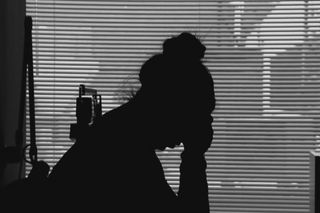
The Difference Between Feeling Anxious and Having Anxiety
Understanding the difference between temporary emotions and persistent states is critical to normalizing mental health care.

Do you feel anxious, or do you have anxiety, or do you have an anxiety disorder? The question may feel like splitting hairs, but it’s actually critical to conversations around mental health. When we conflate natural, temporary emotions like anxiousness with chronic states like anxiety, we undermine the seriousness of mental health struggles and make it more difficult for people to get the help they need.
“Words matter, and science is no exception,” Scott O. Lilienfeld said in a statement last year. Lilienfeld is a professor of psychology at Emory University who co-authored a paper identifying and defining commonly misused psychological terms. When we classify normal, temporary feelings of anxiousness as anxiety, we do a disservice to someone with actual anxiety; our exaggeration minimizes their struggle. When we minimize mental health struggles, we feed damaging myths that these struggles are only experienced by the mentally weak, and that seeking mental health care is a sign of weakness.
What does it mean to feel anxious?
Feeling anxious is a natural, emotional response to stress. Everyone, at various points throughout their lives, experiences anxious feelings. They may not necessarily be fleeting, but they are temporary and tied to a specific event or trigger.
Anxious feelings can be helpful. The concern we feel can motivate us to analyze what went wrong, solve problems, work harder, prepare better, even remember more clearly. Anxious feelings can either be about what might happen in the future (worry), or what has already happened in the past (rumination).
Related on The Swaddle:
Understanding Depression (With a Capital D)
Regardless, depending on the degree of stress someone feels, they might experience physical symptoms, too — think of sweaty palms, hammering heart, and shallow breathing someone might experience when going into, say, a big presentation or exam. Anxious feelings are often reported as occurring at night, keeping those who experience them from getting enough sleep (which can feed the anxious feelings). These physical effects occur because anxious feelings signal the body is in stress-response mode — that is, the evolutionary fight-or-flight mode, a state that prompts physiological changes aimed at keeping the body awake and primed for either running fast or fighting for survival. But these physical experiences of anxious feelings also pass; you may lose a few nights’ sleep over a sick child, or your heart might pound when you think about giving a speech later in the day, but these physical symptoms don’t get in the way of the functional basics of day-to-day living and end when the stressor is gone.
Critically, for people going through an anxious phase, the anxious feelings never feel disproportionate to whatever is stressing them. People who are experiencing anxious emotions retain the ability to calm themselves, so their anxious feelings never spin out of control.
What is anxiety?
Anxiety involves anxious feelings, but everything is kicked up a notch. The mental spirals of worry and rumination become tighter, sometimes meta — the anxious thoughts might kick off anxious feelings about the anxious thoughts. The defining thing about anxiety is that the anxious feelings become disproportionate to the stressor.
Anxiety debilitates the ability to deal. Someone who is simply feeling anxious might feel nervous in the few days leading up to starting a new job. But someone with anxiety might obsess over nervous thoughts for weeks leading up to the start date. In other words, the ability to self-calm and cope is hindered, allowing anxious feelings to amplify and run amok.
Anxiety is also differentiated by more intense and varied physical symptoms, including:
- Dizziness or feeling faint
- Racing or irregular heartbeat
- Sweating or trembling
- Headaches
- Nausea or loss of appetite
- Difficulty speaking
- Difficulty breathing
- Difficulty sleeping
- More frequently needing to use the bathroom
and by more intense and diverse mental and emotional symptoms, which could include:
- Feeling irritable
- Not being able to relax
- Feeling tearful
- Difficulty focusing or paying attention
- Racing thoughts
Some people could maintain tenuous control over their anxiety, perhaps through personal pep talks, journaling, or support from friends or family. Their ability to cope might be inhibited, but still somewhat functional, but may not improve again, no matter how hard they try.
For others, anxiety is persistent, completely out of their control and an obstacle to leading a normal life:
What is an anxiety disorder?
Over time, anxiety can become an anxiety disorder. An anxiety disorder is a very common mental health condition characterized by chronic symptoms of anxiety, often with no clearly identifiable or reasonable stressor.
For people with anxiety disorders, typical living may be disrupted or impaired because of their emotions and thoughts. They might find themselves avoiding certain everyday situations or environments. Commonplace tasks — for instance, paying a bill — that most people can deal with relatively easily can become as stressful as serious threats for someone with an anxiety disorder. This state should be ongoing for at least six months, to qualify as clinical anxiety, and can affect work or school performance and relationships. Some people with anxiety disorders report feelings of detachment from reality — that their responses to situations don’t match others’, or what is actually occurring around them.
Related on The Swaddle:
What It’s Like To Live With: Clinical Anxiety
The cause of anxiety disorders isn’t precisely clear; like most mental health conditions, the cause is a mix of factors, including genetics (anxiety tends to run in families), brain chemistry, individual personalities and experiences. Women are more likely than men to be affected by anxiety disorders, andthough the cause isn’t precisely clear, researchers credit a mix of biological and social factors (e.g., mental or physical abuse) unique or more common to women.
Anxiety disorder is an umbrella term for many distinct conditions. The most common include:
- Generalized anxiety disorder (GAD), which is characterized by constant tension and anxious thoughts, even with no specific triggers.
- Obsessive-compulsive disorder, which involves recurring, specific worry and/or repetitive behaviors/rituals aimed at preventing the worrisome thoughts.
- Panic disorder, which is characterized by panic attacks — repeated and sudden episodes of intense, general terror and feelings of doom along with physical symptoms like difficulty breathing and a racing heartbeat, among others.
- Post-traumatic stress disorder (PTSD), which can develop in response to a traumatic experience or event.
- Social anxiety disorder, or social phobia, which is characterized by extreme discomfort and self-consciousness in everyday social situations.
When to seek help for anxiety
The thing about mental health care is that it can address a range of ailments. Just as health care can mean treating a cold or cancer, mental health care can mean helping someone going through an anxious period to cope better, or it can mean treating a diagnosable anxiety disorder. You can seek mental health care for anxious feelings, or for anxiety, and/or for a diagnosis of an anxiety disorder. It really just depends on when you feel you need help. And if you’re not quite sure how you’re feeling, you can try taking a mood self-assessment survey (try this one, from the U.K.’s National Health Service); it’s not a replacement for a diagnosis, but it might help clarify what you’re feeling and to what intensity.
Intensity is important; mental health professionals typically advise seeking help when anxiety starts feeling disproportionate to the stressor (or has no stressor) and unmanageable on one’s own. If you struggle to or are unable to calm yourself, consider seeking professional help.
The good news is, even if an anxiety disorder is diagnosed, it is treatable. Anti-anxiety and anti-depressant medications can help get symptoms under control. Therapy, too, is an important component; many mental health professionals recommend individual or group talk therapy led by a mental health professional, and/or cognitive-behavior therapy— a line of therapy aimed at helping individuals identify and challenge negative thought patterns, as well as the triggers behind them, in order to disrupt the chronic spiral of anxiety. Exercise, refining stress management techniques and coping skills, and meditation can also aid both people struggling with anxiety and anxiety disorders (though these aren’t replacements for the professional care required by the latter).
Ultimately, anxious feelings are a normal part of being human, which means anxiety and anxiety disorders are, too. Another perfectly normal human experience? Getting a little help when things feel out of control.
Liesl Goecker is The Swaddle's managing editor.
Related


Menstrual Cup Companies Struggle to Go Mainstream in India
